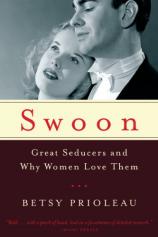Author Talk: February 8, 2013
In 2003’s SEDUCTRESS, Betsy Prioleau examined history’s most powerful sirens --- women who used their smarts, charm and desirability to conquer and fascinate the men of their choosing. Ten years later, she has written about their male counterparts in SWOON: Great Seducers and Why Women Love Them. In this interview, Prioleau discusses her fascination with people who always seem to get lucky in love and enchant everyone around them. She also compares and contrasts the ladies’ men of yesterday and today, talks about the findings that surprised her the most from her research, and explains why she believes women need ladies’ men now more than ever.
Question: In your first book SEDUCTRESS, you examined history’s most powerful sirens, women who used their smarts, charm, and desirability to conquer and fascinate the men of their choosing. What made you want to write about their male counterparts in SWOON?
Betsy Prioleau: In both cases I was fascinated by the mystery of erotic power --- why some people always seem to get lucky in love and enchant everyone around them. This time, I focused on ladies’ men because I was curious to see what made them tick and if they’d been equally misunderstood.
I discovered, sure enough, that they’d been just as distorted and maligned as their female counterparts and had never been studied as a group before. And what a fabulous group! They explode all the stereotypes and possess a cache of love arts that aren’t found in standard relationship or dating guides. Most importantly, these great lovers answer history’s oldest question: what do women want?
It’s time, I realized, to even the score; reveal the kind of men women crave and the well-guarded secrets of female desire.
Q: Can you track any changes in seducers over the centuries? If so, can you spot any constants in the personalities and strategies of these ladykillers?
BP: If you look at seducers over time, you can see shifts in preferences. A medieval exemplar, for example, was a modest knight who served a ladylove with brave deeds, courtesy, and abject adoration. Heartthrobs of the Romantic period, on the other hand, were erotic tornados --- outsized men of operatic declarations and rash actions. Then there were the pony-tailed minstrels and anarchs of the 1960s.
But amid these fluctuations of erotic tastes, you find a number of constants. All these great lovers radiate sexual charisma, cherish women to an unusual extent, and use the same basic method to enamor and keep women enamored and fascinated. They handle love as an art, an imaginative creation, and invest it with drama and originality, customizing charms for individual women.
Q: Who are the ladies’ men today? What are their chief allures and strengths as contrasted with those of the past?
BP: Hollywood heartthrobs like Hugh Jackman, Ashton Kutcher, Ryan Gosling, and Johnny Depp and the real-life men I interviewed for SWOON are ladies’ men with a postmillennial difference. In all the basics, they fit the template: they have that wow factor, love women, and are creative romancers.
But they share some qualities unique to twenty-first-century ladykillers. Reflecting the tastes of today’s independent and confident women, they’re less macho, more expressive and more appreciative of feminine strength and ambition. There’s also a new attention to the male body beautiful (the female gaze has been liberated!), although one large-scale study found that women tend to like a loved one’s appearance, regardless of stated ideals. If riches and rank ever mattered, they seem increasingly irrelevant. Only two of my women-charmer subjects were wealthy, and celebrity love gods are portrayed as guys in sweats next door rather than plutocrats. Women don’t require sugar daddies any longer; they want interesting peers. As women alter so do the men they crave, but their romantic needs, at base, claims a 2012 study, “haven’t changed one bit.” Which is why ladies’ men today resemble more than differ from the long line of historical great lovers.
Q: Is it harder to be a ladies’ man in contemporary society? If so, why?
BP: For the ordinary guy in contemporary society, it’s definitely harder to be a ladies’ man. There are no longer courtship rituals or etiquette guides on how to charm. Men get their erotic education, such as it is, from porn, locker rooms, cursory sex-ed classes, the media, and couples’ therapy bromides --- none of which address lovecraft.
Then, too, they’re mis-educated in seduction by pick-up artist flak and intimidated by heightened female romantic and sexual demands. Without the old need for the male initiative, many men have grown passive and abandoned the mating effort altogether.
On the other hand, there’s a select fraternity of ladies’ men today who’ve circumvented cultural pressures and are tearing up the track with women. It just requires the right stuff, the strength to buck the tide and the will to woo.
Q: In SWOON you use evidence from science, popular culture, fiction, anthropology, history, and interviews with real-life ladies’ men to reveal who these master lovers really are and how they enswoon women. What findings surprised you most from your research?
BP: I approached ladies’ men like anyone else, full of preconceptions. So everything --- the way they overturned all the ingrained beliefs --- was a surprise. But the biggest, I’d say, was the realization that they weren’t romantic predators; the majority are more pursued than pursuing. As Albert Camus wrote in his journal: “I don’t seduce, I surrender.”
What equally amazed me was how ordinary they are on the surface --- unhandsome, as a rule, and without rank or riches. I was also taken aback by their sincerity. They’re genuine women lovers who don’t fake their seductions and fall in love with astounding regularity.
Their complexity threw me, too: mixed in with their amorous ambitions are a number of unexpected --- often positive --- traits, such as spirituality and moral idealism.
Q: In your first book, you revealed that many seductresses throughout history were androgynous. In SWOON, you share that androgynous men are also immensely seductive. What it is about gender ambiguity that is so appealing?
BP: The androgyny of ladies’ men, though, was the real shocker. Instead of the expected Darwinian alpha male, great seducers tend to have a strong feminine streak. As with seductresses, gender ambiguity is immensely seductive. Lord Byron, the nineteenth-century romantic idol, looked like “a woman dressed in man’s clothes,” and was effeminate in speech and affect. And the American film icon of manhood, Gary Cooper, “more beautiful than Garbo,” was celebrated for his “ravishing androgyny.”
Cultural scholars think this attraction is deeply embedded in eros. They conjecture that both genders possess an inner bisexuality in the depths of the psyche and we never lose a desire for synthesis of male and female. It represents the “peak of sensual perfection,” they claim. The earliest sex gods, like Shiva and the “Man-Woman” Dionysus, were gender-benders.
In studies, women consistently prefer computerized images of feminized male faces and choose more androgynous men in audio interviews. Sexual psychologist Meredith Chivers determined after extensive work that women share a marked predilection for bisexuality. The allure is deep-seated and exercises a powerful fascination on the male and female libido.
Q: The player or pickup artist persona popularized by Neil Strauss and dozens of online dating gurus is one of the most pervasive stereotypes of the ladies’ man. In SWOON, you explain that the PUA (pickup artist), is the furthest thing from a real seducer. Why is this so? And how did Strauss get this so wrong?
BP: The player model of the seducer is one of the most pathetic, noxious versions of the ladies’ man. It’s the brain child of a sad assortment of undatables who sold insecure men on the idea that women are won through dominance displays and paramilitary maneuvers. Apprentice players learnt to game targets with bravado, sarcastic put downs, trance words, and “kinos,” strategic touches.
The goal is modest: to get laid not loved, and the “hits” who fall for these puerile ploys are usually a desperate lot themselves --- lost, lonely singletons and demoralized strippers. Neil Strauss and his confreres didn’t do their homework. Real ladies’ men who captivate the best women are secure and mature, and court conquests with praise, pleasure, and passionate artistry.
Q: What does the overwhelming popularity of FIFTY SHADES OF GREY and romance novels in general say about today’s sexual culture?
BP: Romance novels are a fabulous window onto the female libido. The heroes in these fictions reflect women’s wildest erotic dreams. They’re ardent sexperts, suitors, pleasurers, and praisers, and deify their girlfriends. They’re also coincidentally a lot like great lovers of the past and present.
The runaway popularity of FIFTY SHADES OF GREY is a measure of the contemporary female longing for the ladies’ man and what he brings to love. Instead of a yen for S & M, the trilogy is really about women’s unfulfilled romantic desires, the wish to be the center of a man’s universe, to be madly cherished, satisfied, and noticed, and never bored.
It speaks volumes about women’s heightened romantic expectations and the extent to which they aren’t being met today by men, many of whom have lost interest in love and love maintenance and have called it a day.
Q: In SWOON, you argue that women in contemporary culture need ladies’ men more than ever? Why is this so?
BP: Rarely have women needed ladies’ men more than they do today. As trend-trackers continually remind us, it doesn’t look like a season for romance out there. We have confusion and cynicism and a climate of “liquid love” --- revolving partners, light attachments, and melancholy marriages. A sexual malaise seems to have sunk over the country. Women, according to studies, want change. They’re weary of the role of aggressor, frustrated sexually (the orgasm gap persists), and increasingly peeved with men. Neglect is the most common reason for breakups, and female infidelity is on the rise. They’ve become unhappier since 1972 (in part due to men), and are demoralized --- discontented with their looks and unsure of their romantic moves.
This is where ladies’ men come in. They come on strong, romance women with ardor and style, and sate them sexually. They don’t do dull, and make women feel anointed --- gorgeous, special, and thoroughly appreciated.
Q: After writing this book, what do you think women really want? And are men today really interested in fulfilling these desires?
BP: In essence, women want what we all seek in love: to be truly seen and adored by a loved one who rocks our world. Who pays attention and keeps passion fresh through perpetual courtship.
Men are more interested in fulfilling this desire than at first meets the eye. Beneath the macho bluster, many men, according to recent research, are closet romantics, anxious to please. They fall in love at first sight more often, prefer romantic over sexual images on tests, yearn equally for long-term unions, and fare worse emotionally after break-ups. “Love,” writes Garrison Keillor of men, “is the mainspring of our lives.”
Q: What do you hope readers will take away from this book?
BP: My hope is that readers will come away with a more nuanced view of the ladies’ man, will appreciate his significance in cultural history, and see his uses for today. He’s a privileged window onto what women want.
He doesn’t have to be taken wholesale --- flaws and all. We can harvest his love secrets and arts and teach them to ordinary men. As the love philosophers say, “every man should be Don Juan to his wife (or partner) over and over and over again.”




